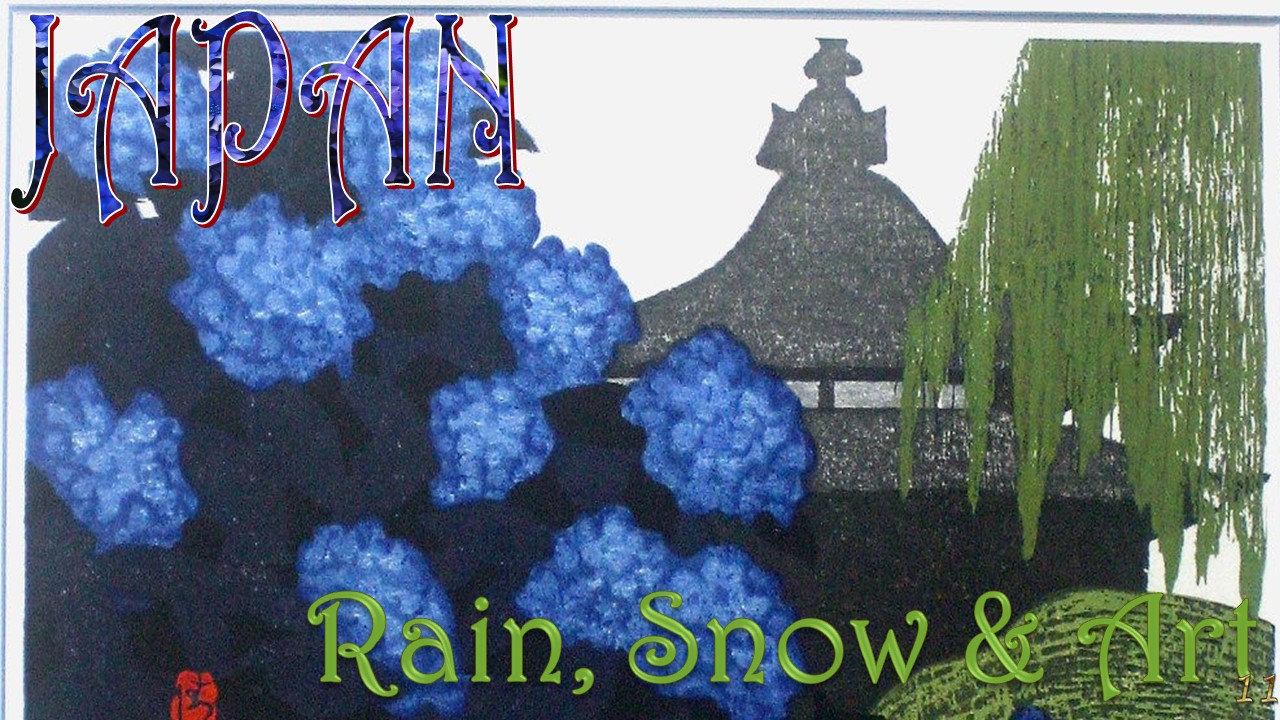Japan Rain, Snow & Art11 - PowerPoint PPT Presentation
Title:
Japan Rain, Snow & Art11
Description:
Hydrangea (Ajisai in Japanese) is the sign of the rainy season in Japan. The flower is adored and honored by most of the Japanese like they do for ume, sakura and irises. Hydrangea themed accessories found in Japan are quite famous. It appears as a popular decorative motif such as in Kimono, woodblock prints, paintings, tableware, jewelry, and other home decor accessories – PowerPoint PPT presentation
Number of Views:4
Title: Japan Rain, Snow & Art11
1
JAPAN
Rain, Snow Art
2
(No Transcript)
3
Sakai Hoitsu Hydrangea and Poppy
Sakai Hoitsu (1762-1828) Hydrangea
A hydrangea, called Ajisai is the symbolic
flower of the rainy season, reminding the
Japanese of a sense of mild compassion by its
pastel colors Hydrangea usually blooms from
mid-Jun to early July after tsuyu, the long rainy
season. Therefore, when the long period of tsuyu
comes to an end, one of the most important events
of Japanese people is to enjoy the beauty of
Hydrangea
4
Hoitsu Sakai (1761-1828) Peegee hydrangea and
Madagascar periwinkle
Hoitsu Sakai
5
Hoitsu Sakai (1761-1828), Kiitsu Suzuki
(1795-1858) and Kimei Nakano (1834-1891), Pomegran
ate and bigleaf hydrangea
Hokkei Totoya (1780-1850) Bigleaf hydrangea and
unknown bird
6
Ichinose Reiko 2011
Kazuo Kakurai (1919-1995) Bigleaf hydrangea and
green peafowl
7
Japanese Tenugui Cotton Towel Fabric, Hydrangea
8
Hydrangea Dress Japanese Vintage Dress
Japanese Style Card Blank Hydrangeas and Peony
9
Isao Kawahara (1915-)
Katsue Inoue (1932-)
10
Issei Nomura (1921-)
Katsunosuke Ikeda (active late 1900s)
11
Ito Jakuchu (1716-1800)
Hydrangea and White Rooster. Japanese hanging
scroll. Ajisai Hakukei Zu. Circa 1755
12
Ito Jakuchu (1716-1800)
13
(No Transcript)
14
(No Transcript)
15
(No Transcript)
16
Ito Jakuchu (1716-1800)
17
Ito Jakuchu (1716-1800)
18
Ito Jakuchu (1716-1800) Hanamaruzu (Hydrangea
macrophylla)
19
Jean-Pierre Cassigneul (French, 1935-) Devant
la porte 1985 tapisserie
20
Jean-Pierre Cassigneul (French, 1935-) Hortensia
21
Jean-Pierre Cassigneul (French, 1935-)
Hortensia 92 ? 73
22
Jean-Pierre Cassigneul (French, 1935-)
23
Jean-Pierre Cassigneul - La terrasse aux
hortensias 2014
Jean-Pierre Cassigneul (French, 1935-) Les allées
du bois 1983
24
Jean-Pierre Cassigneul (French, 1935-)
25
Jean-Pierre Cassigneul (French, 1935-)
26
Jean-Pierre Cassigneul (French, 1935-)
27
Jinghua Gao Dalia Kyoto Garden 2012
Kawanabe Gyosui (1868-1935) Blue Bird on a
Blossoming Branch
28
Kaneko Seiji 2011
Kamisaka SEKKA (Japan 18661942) Momoyo-gusa Ni,
1909
29
Kakudo Yabu (-1849)
30
Katsushika Hokusai (1760-1849)
Imao Keinen (1845 - 1924)
31
Katsushika Hokusai (1760-1849)
32
Katsushika Hokusai (1760-1849) fragment
33
Katsushika Hokusai (1760-1849) details
34
Kawashima Masayuki Hydrangea Japanese painting
Kazuo Masui (1908-1991)
35
Kayoko Miyayama (1955-) After the rain
36
Kayoko Miyayama (1955-) After the rain
37
(No Transcript)
38
2012
39
In Japan, hydrangea has another Japanese name,
nanahenge, which means it has seven changes. The
reason why the flower gets this name is because
the color of the petals of hydrangea can change
according to the nature of the soil. On the basis
of the soil PH, the color of the petals can turn
to dark blue, light blue, light purple, purple,
white and so on. Therefore, the flower looks
different at every moment
40
The delicate and subtle combination of colors
makes hydrangea more attractive. Also, this
distinctive feature has given the flower a rich
symbolic meaning in Japanese literature. In
Japanese poems as well as the fine art works, the
flower is often used to represent the fickle and
changing heart
41
(No Transcript)
42
Text pictures Internet All copyrights belong
to their respective owners Presentation
Sanda Foisoreanu
2017
Sound Teresa Teng - Myth of lovers
Life































